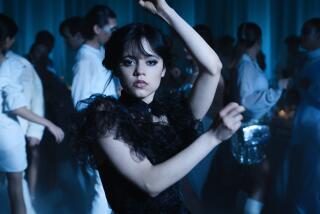New Cartoons Are Draw On Some Old Animation Traditions
- Share via
“What really doesn’t work for me about television animation is that the medium has moved into a let’s-draw-characters-who-look-like-the-people-on-TV mentality and away from the elements that make animation so wonderful,” says Fred Seibert, co-executive producer of “Oh Yeah Cartoons!”
“Also, the business side of TV automatically commits to an entire series worth of production at a time. In the heyday of the great animated shorts, cartoons weren’t done in batches of 100. They would make one at a time, so the artists could see what happened and what worked. I suggested we try a similar approach to the executives at Nickelodeon.”
“Oh Yeah Cartoons!,” which debuts Sunday on Nickelodeon, is a major departure from standard TV animation in both style and format. Each of the 13 half-hours consists of three six-minute shorts, featuring different characters done by different artists in different styles. Even the title of the series is a break with tradition: Instead of the name of a character or a toy, it’s a tribute to the 1958 Charles Mingus album “Oh Yeah.”
Seibert began exploring the concept of making original short films for television with the 1995 series “What a Cartoon!/World Premiere Toons” that he produced for the newly founded Cartoon Network during his tenure as president of Hanna-Barbera. For “What a Cartoon,” Seibert produced 16 shorts a year for three years; for “Oh Yeah Cartoons!,” the 17 artists Seibert has assembled have created 36 new shorts for its debut season alone. (The remaining three cartoons are animated pilots Nickelodeon had previously commissioned.)
“With 36 brand-new films, we’re introducing more new characters than anyone else in television can in a year,” Seibert says enthusiastically. “There are business goals that Nickelodeon has: They want to find successful characters and series. I have personal goals, which are both grander and simpler: to take the resources available at a given moment and blow the roof off the expectations of my friends and competitors.”
If the first episode is any indication, Seibert’s claims for “Oh Yeah Cartoons!” are largely justified: Each film is very different from the other two. The level of originality is higher than usual for TV animation, although the results are somewhat uneven. In “ChalkZone,” the most appealing and imaginative of the three, a small boy discovers a magic world behind his classroom blackboard, where everything ever drawn and erased still lives, including a portrait of himself as a superhero and a caricature of the class bully as a monster. The boy and his alter ego defeat the monster in an adventure that recalls “Bobby’s World” and “Winky Dink and You.”
“Slap T. Pooch, a bulbous-nosed dog with a British accent, attempts to discover what amuses people in “What Is Funny.” The film contains some nicely absurd moments, including a visit to the Prison for Criminally Insane Gingerbread Men, but an unexplained trio float in and out chanting, “What is funny,” giving the cartoon a decidedly outre tone.
“Jelly’s Day” is the closest to cartoon business as usual. When a square-faced little girl takes her monster cousin Hargus from Entransylvania to the beach, predictably disastrous results ensue.
The engaging “ChalkZone” has the strongest potential for development into an ongoing series. But Seibert cautions, “We’re not even thinking about series at this point. My goal is not to leap into series production but to take the best films from the first 36 and make a few more of them. We’ll continue picking best-ofs and making more to give the best filmmakers a chance to evolve, instead of leaping into a vat of frying oil--which is what series production is really like.”
Determining which shorts will rank as the best films may be tricky. As there are three completely unrelated films in each half-hour, any one of them could raise or lower the ratings for the entire half hour, affecting the audience for other two.
“The evaluation process is more intuitive than one would think,” Seibert explains. “It starts with how my co-executive producer, Larry Huber, and I feel about the filmmaker, the character and the story. The second level is the network’s intuition and the third level involves going and talking to kids--the dreaded focus groups. But over the years, I’ve seen Nickelodeon green-light shows the focus groups said ‘no’ to and not produce things the focus groups said ‘yes’ to. I like to think of focus groups as a disaster check on your intuition.”
Seibert acknowledges that the program’s format is potentially risky in many ways. Ordinarily, producers on animated series can take advantage of certain economies of scale: As the animators learn to draw the characters, they draw faster. Runs, walks and other stock movements can sometimes be reused.
But each film in the “Oh Yeah Cartoons!” has a different cast of characters and wildly divergent graphic styles, which means the artists have to start from scratch on each six-minute short. A larger than average budget is required, so more is at stake.
“From a business point of view, Nickelodeon is taking the biggest creative risk in all of animation, because it could all go south,” Seibert says.
“When the Cartoon Network went on the air with the stuff we’d done at Hanna-Barbera, they were the new guys on the block; they had nothing to lose. Nickelodeon has everything to lose, but they’re giving us a half an hour of time and a high per-episode budget. I believe that’s why Nickelodeon will remain popular: They take risks at the apex, rather than at the nadir.”
* “Oh Yeah Cartoons!” is broadcast Sundays at noon on Nickelodeon.
More to Read
The complete guide to home viewing
Get Screen Gab for everything about the TV shows and streaming movies everyone’s talking about.
You may occasionally receive promotional content from the Los Angeles Times.






